Travel in Brittany: The Magic of Morbihan
Making quite the entrance by boat, Marion Sauvebois hops on the trail of Brittany’s ancient stones, medieval mascots – and mastermind thieves…
I wave back with my free hand at the dog-walker gesticulating in our direction from the towpath. “Look, a welcome party,” I shout over my shoulder, gaff now cocked, ready to leap off any second to moor our little boat.
“Je viens vous aider!” bellows the man suddenly, sprinting towards us.
“What’s going on?” My partner, Sean, pokes his head from the cabin. Before we’ve quite realised how, the man, blotchy red from effort, has grabbed hold of the rope and is single-handedly tugging our mini yacht to the bank – our babbled protests falling on deaf ears; though he may be straining to hear over the din of ‘In the Navy’ pumping from the deck.

Marion’s boat moored at last.
Just like that we’ve had a rescue mission sprung on us. The craft safely moored, our puffing saviour, Michel, stares incredulous at Sean’s party-shop Captain’s cap and scolds, not unkindly: “C’est la Bretagne ici!” As though we’ve drifted along the Nantes-Brest Canal under the mistaken impression this was the Riviera.
Moratorium on The Village People and costumes it is…
In hindsight, the boat instructor’s offer to escort us from Glénac Marina to the first lock half an hour previously may not have been a token of Breton hospitality – or superior customer service – after all. As Michel puts it over a bolée of cider later: “He’d seen you coming.”
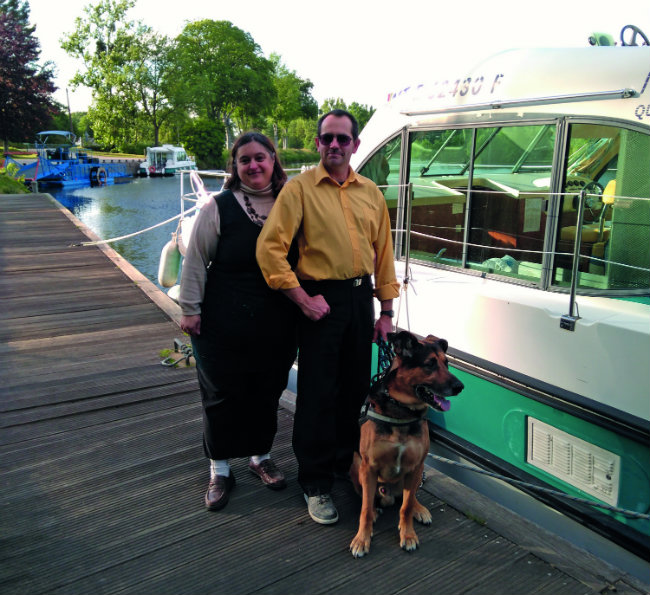
The boat is moored thanks to Michel. Photo: Marion Sauvebois
Determined to see this boating lark through, we resume our cruise undaunted the following day. But after a pleasant (and rescue-free) second stab, it becomes clear that our carefully- planned navigation schedule may be a tad optimistic. It does not factor in: A) our ‘leisurely’ cruising speed; B) the lock-keeper’s sacrosanct 90min lunch break; C) the logistics of shoehorning a bateau through a sluice gate. So, a little red-faced, we are forced to abandon ship – do I detect the faintest sigh of relief from the marina master? – and jump in the car to make tracks on our whistle-stop tour of Morbihan.
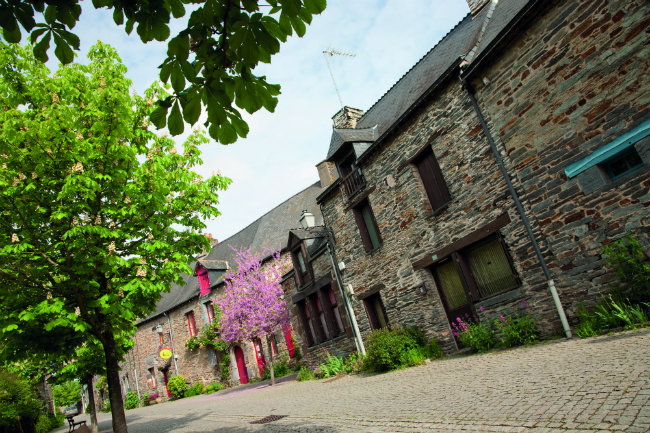
La Gacilly is home to cosmetics tycoon Yves Rocher’s botanical gardens. Photo: Franck Hamel
ON THE ROAD AGAIN
A rev and tootle from Glénac Marina on the gentle banks of the canal, La Gacilly appears into view. Once a struggling village, the idyllic nook’s fortunes changed when its most famous son and natural cosmetics tycoon Yves Rocher – who rose to fame after inventing a herbal cure for haemorrhoids – installed his growing empire in his hometown. A coterie of artists and brocanteurs wasted no time in snapping up La Gacilly’s crisscross of red-shuttered stone cottages and turning the new tourist hotspot into a bastion of creativity – and eccentricity…
Venturing into one such brocanteur en route to Yves Rocher’s botanical gardens (the spectacular collection of 1,000 plant species alone is worth the stopover in La Gacilly), my partner is pulled aside by the shifty-looking owner with a “Wanna see something French?” To his horror, the grinning man slips him a wad of 1920s pornographic postcards. It is clearly an honour bestowed on select customers. “C’est bien,” poor Sean manages before bolting out the door. I can’t decide whether I should be flattered or alarmed he met the brocanteur’s careful vetting…
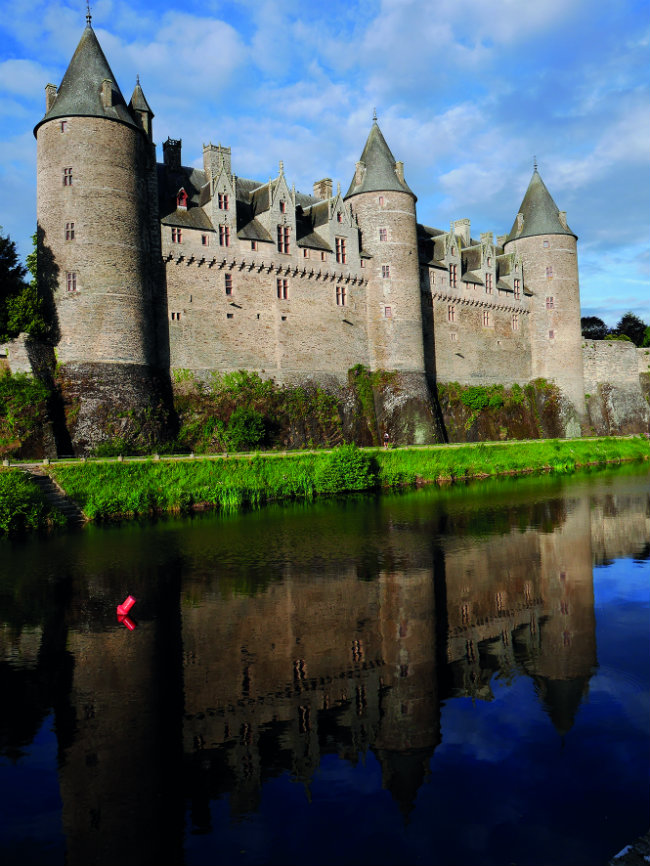
Château de Josselin. Photo: CRT Bretagne
THE PLOT THICKENS
The uncouth ambush still a hot topic, we double back and head off to our final stop along the canal: Josselin and its storied castle.
A medieval fortress-cum-flamboyant Renaissance palace, the granite-hewn Château de Josselin has borne the brunt of French history. Once a strategic stronghold in the Breton Guerre de Succession, it was later nearly razed in the last throes of the Wars of Religion under orders of Cardinal de Richelieu to cow its heretic (Protestant) owners, the mighty Rohans in the 17th century. Easier said than done, it turned out. Josselin’s forbidding keep was also used as a makeshift gaol for aristocrats awaiting their tête-à-tête with Madame la Guillotine during the French Revolution.
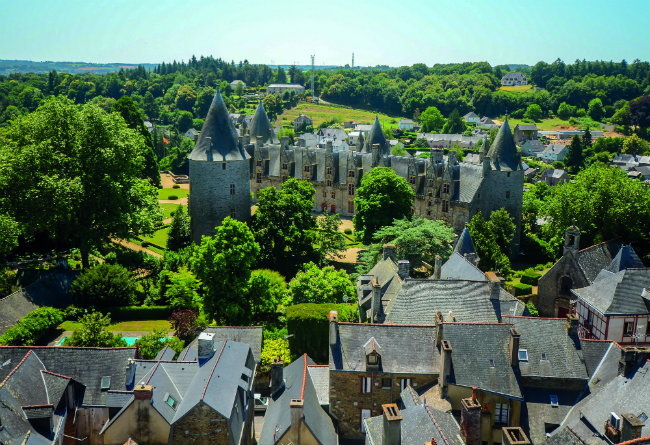
A bird’s eye view of the Château de Josselin. Photo: CRT Bretagne/ Donatienne Guillaudeau
Still owned by the Rohan family, its labyrinthine gardens and lavishly furnished interiors tickle the imagination. But it’s for a glimpse of its peripatetic clock that throngs of rubberneckers trek up the warren of twisting medieval alleyways each year. That, and its Grand Escalier, the first ‘straight’ staircase in France when it was built in 1510.
The coveted gilded Louis XV mantle clock gracing the grand living was pilfered not once but twice in the last 30 years. The second, Hollywood-style, heist still smarts. Robbers slipped in on the night of France’s World Cup win back in 1998, our animated guide reels off at a mile a minute. Amid the ruckus of baying crowds, tooting horns and merrymaking, no-one heard the blare of security alarms as they made off with the 70kg timepiece. It took two years, a demand for ransom, briefcase exchange and eventual standoff with police in Rotterdam to recover the antique (from a car boot). The operation brought down an international gang, which had raided more than 500 French châteaux, including the home of former president Giscard d’Estaing.
And on that nugget, we’re escorted swiftly out of the treasured pendule’s reach. Our jaunt along the canal complete, we zip off to Morbihan’s mighty Gulf and its postcard-perfect capital, Vannes.
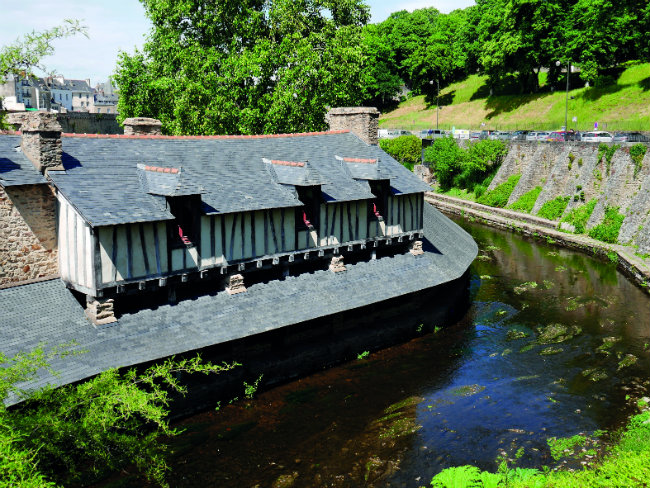
Lavoir de la Garenne in Vannes. Photo: CRT Bretagne
VANNES… ET SA FEMME
“Bit creepy,” Sean whispers, craning his neck to examine Vannes et sa femme, the harbour town’s handless figureheads, snug in the niche of a
maison à pans de bois. As mascots go, a pair of eerie carvings with stumps for hands is a strange choice.
No-one quite remembers how they came to be Vannes’s emblem, or maimed for that matter; but paying your respects before edging into the depths of the walled city is de rigueur.
“History is etched on every stone,” explains our guide, pointing out the remnants of the early Roman foundations at the base of the ancient ramparts. Stepping through the monumental St Vincent Ferrier gate and ambling along the rainbow of crooked half-timbered abodes and grand 17th-century hôtels particuliers – built for the cabal of Rennes parliamentarians condemned to mass exile by the Sun King for failing to quell rebellion – every last cranny, it seems, speaks to the sweep of history.
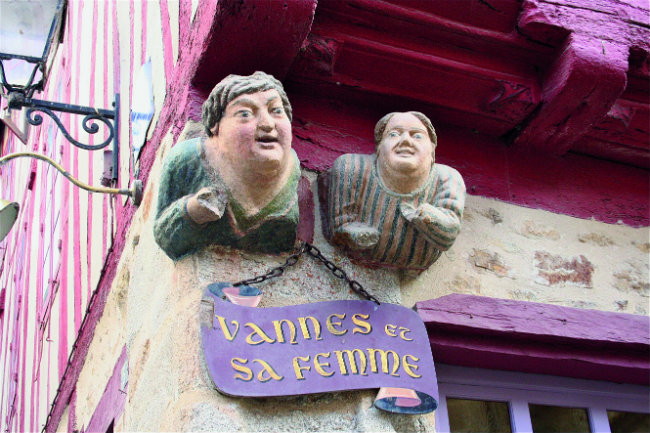
“Vannes et sa femme” are the eerie mascots of the town. Photo: Fotolia
It is hard to imagine it all gone. And yet, had megalomaniac mayor Émile Burgault had his way at the tail end of the 19th century, few of these listed treasures would be left standing.
Hell-bent on erecting a town hall rivalling Paris’s opulent Hôtel de Ville, he spared no expense. His delusion of grandeur also involved tearing through the lattice of maison à pans de bois to make way for a sweeping Haussmann-style avenue. Branded the “Folie Burgault” by the incensed press, the breathtaking pet project drained the municipal coffers, putting a screeching halt to his planned bulldozing spree. “20 years later the town was still paying for it – needless to say he wasn’t re-elected,” quips our guide. Today’s Vannetais don’t seem to hold a grudge as a street shooting off from his spectacular Hôtel de Ville is named after the spendthrift republican.
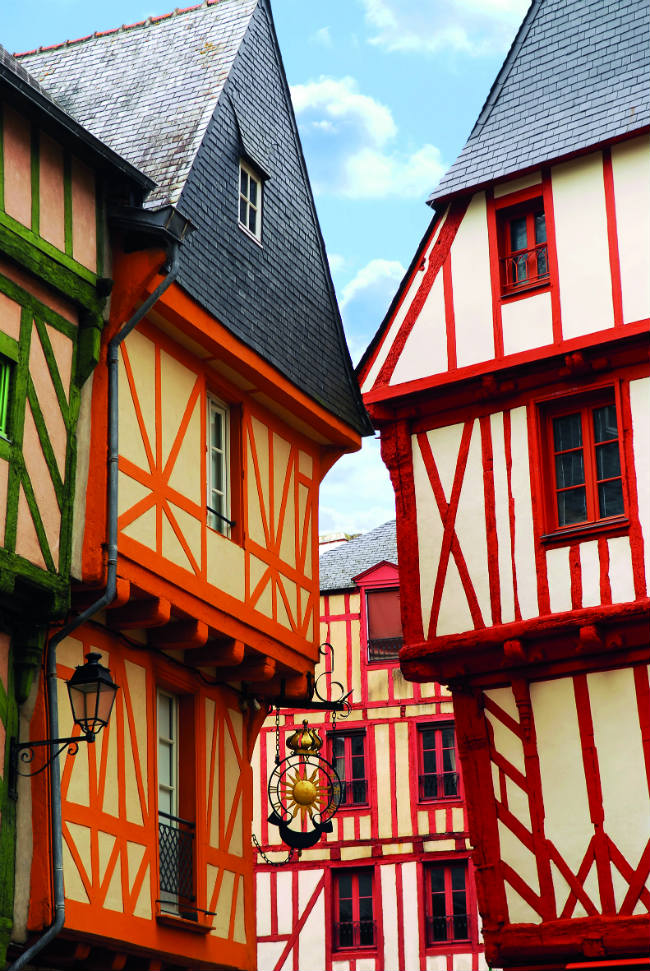
Vannes’ picture-perfect “maison à pans de bois.” Photo: Fotolia
MYSTERIOUS MENHIRS
Nothing can quite describe the wind-knocking approach to the megaliths of Carnac. As we inch closer to the 3,000 mystical stones, the largest cluster in the world, rising in neat rows along the road, it’s all I can do not to squeal. Though I am slightly taken aback by the metres of chain link fencing off the precious menhirs. Of course, I have callous tourists, my own ill-bred relatives included, to blame for this state of affairs. After being treated like outdoor furniture, playthings (the sepia snapshot of my 10-year-old mother riding a 6,000-year-old menhir like a show pony a prime example) and al fresco loos for centuries, the Alignments of Carnac are now strictly off-limits without a guide in tow.
Made up of distinct ‘structures’ – monumental tombs known as tumuli and dolmens on one hand, and the famous rows of perked-up stones hemming in the burial grounds on the other – these mysterious pierres dressées continue to puzzle archaeologists.
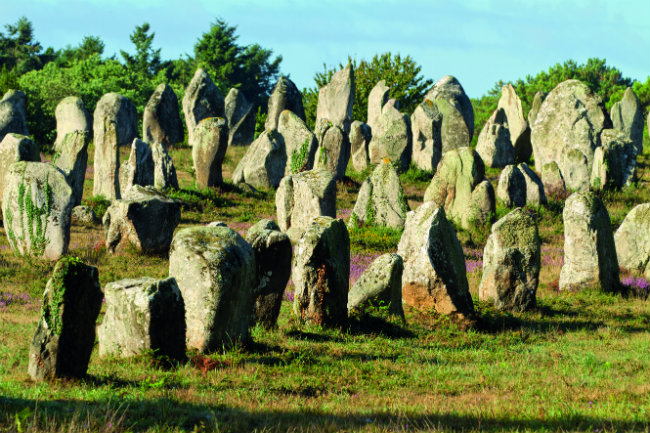
The Alignements de Carnac are 6,000 years old. Photo: Fotolia
One after the other the hypotheses of old – Roman soldiers turned to stone (that one never held much sway in the scientific community)? Ruined temples? Astronomical observatory? – are being debunked. The very term ‘alignment’ is even being thrown into question. The theory taking root these days is that the stones represented a physical, and perhaps mystical, threshold between two spaces or worlds.
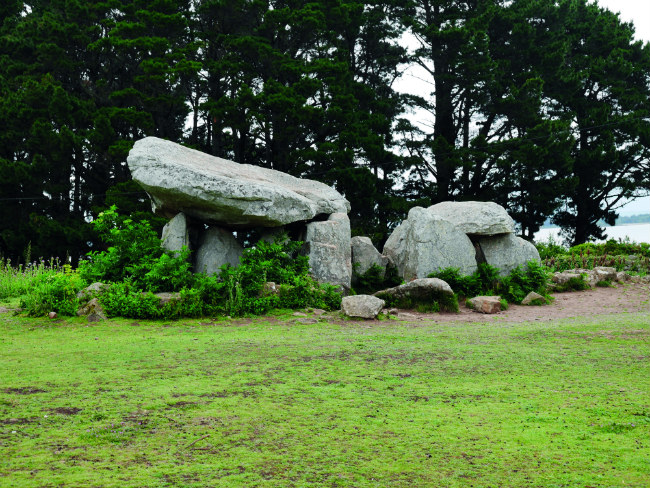
The Penhap dolmen on the southern tip of l’Île aux Moines
But there is consensus on how these hefty “portals” were hoisted up; thanks to extensive research and evidence-based child labour.
“How many nine-year-olds does it take to lift a two-tonne stone?” quizzes our guide.
Two is the answer. In the name of science, every primary school group stepping in Carnac is challenged to test out the neolithic builders’ foolproof hauling technique, which entails ropes and wooden rollers.
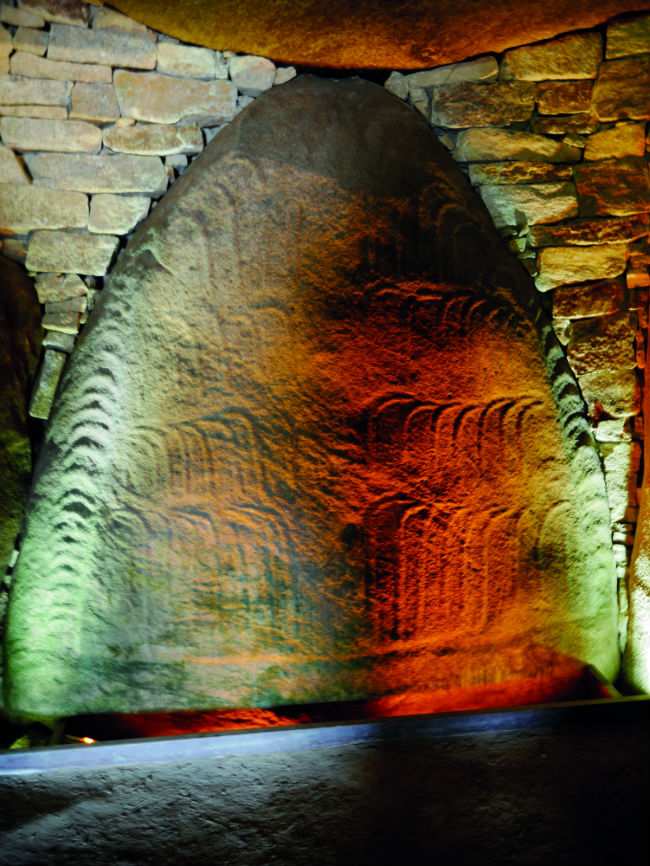
The stele in the Table des Marchands at Locmariaquer. Photo: Marion Sauvebois
GOING ROGUE
While the treasured alignments are shielded by enclosures, in typical French fashion, the scattering of tumuli fanned out in the nearby forest is still fair game. So, armed with a map, we set off on the 4km menhir trail, thrashing through thickets and wrestling with brambles for a glimpse of the Géant du Manio, a towering 6m monolith (the tallest in Carnac). Next up is the elusive Dolmen de Kercado. Clambering through a breach in a nearby château’s outer wall (in all legality of course) is just the beginning. Reaching the funeral chamber is quite the squeeze and requires virtually crawling through a tunnel in complete darkness guided by a rope. Rumour has it, limber royalists hid within its bowels after the Revolution. If so, kudos. Overhearing fellow explorers wax lyrical about the superior wonders of the nearby Locmariaquer site, we scrap our visit to the Quiberon Peninsula and nip off to see for ourselves. Too often bypassed by uninformed tourists (like us) for the off-limit gems of Carnac, it is without a doubt the crowning glory of Morbihan’s standing stones ‘collection’.
Secreted on an atmospheric mound overlooking the Gulf, it is the resting place of the breathtaking Grand Menhir Brisé, a 20m fallen giant broken into four slabs and the 140m Er Grah tumulus. But it is the wondrous Table des Marchands dolmen abutting them which truly beggars belief. Creeping down the otherworldly passageway to behold the engraved stele within is a surprisingly awe-inspiring experience; and by far the climax of our feverish hunt.
But by no means the end of it.
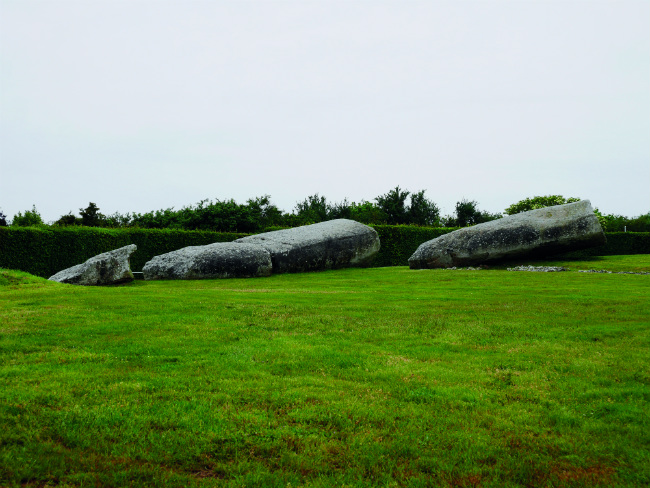
The Grand Menhir Brisé is the longest ever discovered in the west. Photo: CRT Bretagne
Dolmens are not the sole preserve of Carnac and its surroundings: sacred stones pepper the coastline and the Gulf’s idyllic isles. So by daybreak, we’re up and at it again, pushing through the crowds of Baden’s Port Blanc to board the five-minute shuttle boat to l’Île aux Moines – and squeeze in one last stone-spotting jaunt à bicyclette.
Free-wheeling past blue-shuttered cottages and along sheltered coves, we spy the Penhap Dolmen stooped in the lush wilderness and circle the Cromlech de Kergenan, a horseshoe of 24 upright blocks nestled at the heart of the scenic island.
Exhausted and numb in all the right places, we drag ourselves back to Baden harbour, rather subdued as we reach the car.
Within minutes, the pulsing beats of ‘In the Navy’ shatter the silence, literally shaking our old banger. “To Michel!” my partner chants, whipping out his captain’s hat. The perfect swan song indeed. Pardon Michel…
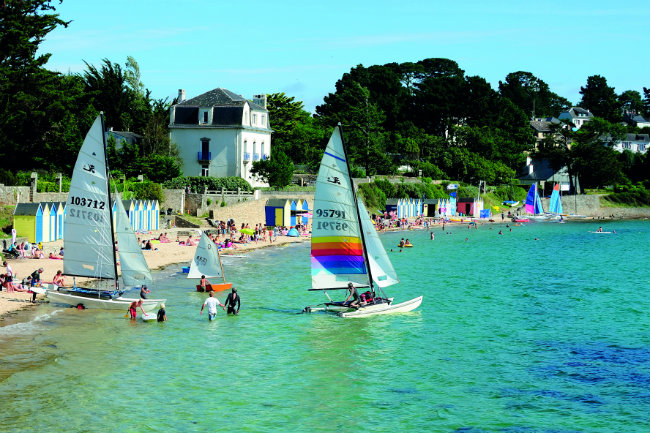
l’Île aux Moines is an idyllic getaway. Photo: Yannick Le Gal
THE LITTLE BLACK BOOK
WHERE TO STAY AND EAT IN MORBIHAN
Maison de la Garenne, Vannes: www.maisondelagarenne.com
Crêperie du Port, Vannes: www.tourisme-vannes.com
Hôtel et Restaurant Le Gavrinis, Baden: www.gavrinis.fr
ACTIVITIES
Marion travelled along the canal courtesy of boating holidays rental company Nicols: www.boat-renting-nicols.co.uk
L’Île aux Moines can be reached by boat from Port Blanc in Baden: www.izenah-croisieres.com
Véloc’Ouest offers bike rentals on l’Île aux Moines: www.velocouest.fr
Château de Josselin: www.chateaudejosselin.com
From France Today magazine
Share to: Facebook Twitter LinkedIn Email
Leave a reply
Your email address will not be published. Required fields are marked *

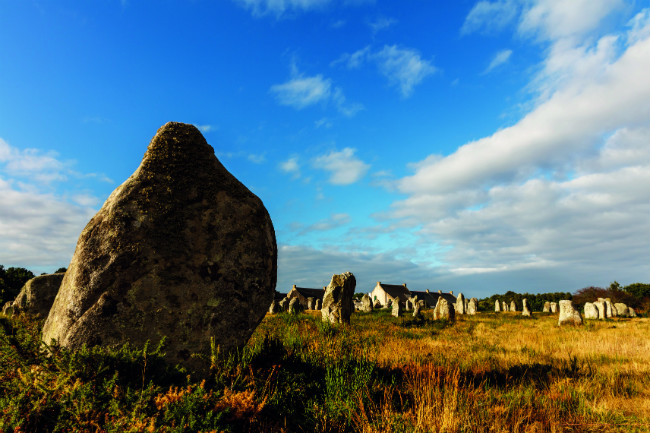




REPLY